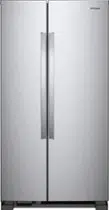Documents: Go to download!
User Manual
- User Manual - (English, French)
- Energy Guide - (English)
- Warranty - (English)
- Specifications - (English)
- Spec Sheet (web) - (English)
- Installation Instructions - English, Spanish, French - (English)
- Dimension Guide - (English)
- Repair Part List - (English)
- MAINTENANCE AND CARE
- REFRIGERATOR FEATURES
- TROUBLESHOOTING
Table of contents
SIDE-BY-SIDE REFRIGERATOR OWNER'S MANUAL
MAINTENANCE AND CARE
Cleaning
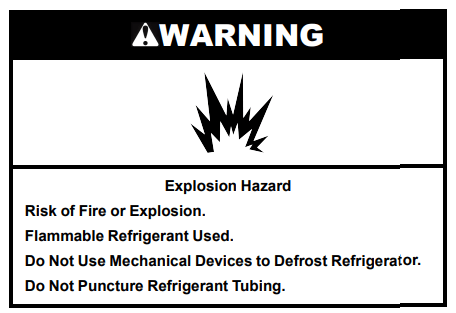
Both the refrigerator and freezer sections defrost automatically. However, clean both sections about once a month to avoid buildup of odors. Wipe up spills immediately.
IMPORTANT: Because air circulates between both sections, any odors formed in one section will transfer to the other. You must thoroughly clean both sections to eliminate odors. To avoid odor transfer and drying out of food, wrap or cover foods tightly.
NOTE: Do not use abrasive or harsh cleaners such as window sprays, scouring cleansers, flammable fluids, cleaning waxes, concentrated detergents, bleaches or cleansers containing petroleum products on plastic parts, interior, and door liners or gaskets. Do not use paper towels, scouring pads, or other harsh cleaning tools. Stainless steel models have a coating. Do Not use regular stainless steel cleaning products. Do Not use stainless steel cleaner or polish and use only mild soap, water, and soft microfiber cloth to avoid damage to the stainless steel protective coating. Paper towels scratch and may dull the clear coat of the painted door. To avoid possible damage, use only clean cloths to polish and wipe the door.
1. Unplug refrigerator or disconnect power.
2.Hand-wash, rinse, and dry removable parts and interior surfaces thoroughly. Use a clean sponge or soft cloth and a mild detergent in warm water.
3. Wash stainless steel and painted metal exteriors with a clean sponge or soft cloth and a mild detergent in warm water.
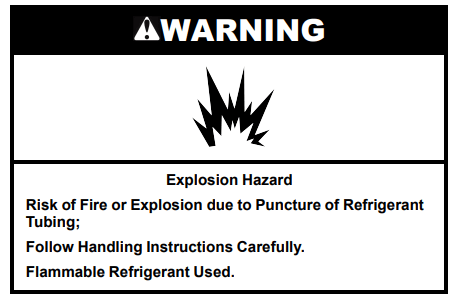
4. There is no need for routine condenser cleaning in normal home operating environments. If the environment is particularly greasy or dusty, or there is significant pet traffic in the home, the condenser should be cleaned every 2 to 3 months to ensure maximum efficiency. If you need to clean the condenser:
- Remove the base grille. See the “Door Removal” instructions, either in the Owner’s Manual or in the separate instruction sheet provided with your refrigerator.
- Use a vacuum cleaner with a soft brush to clean the grille, the open areas behind the grille, and the front surface area of the condenser.
- Replace the base grille when finished.
5. Plug in refrigerator or reconnect power.
Lights
Not all bulbs will fit your refrigerator. Be sure to replace the bulb with one of the same size, shape, and wattage.
IMPORTANT: The light bulbs in both the refrigerator and freezer compartments of your new refrigerator may use LED technology. On some models, the LED light bulbs in the refrigerator, freezer, air tower, and dispenser cannot be changed by yourself. If the lights do not illuminate when the refrigerator and/or freezer door is opened, call for assistance or service. In the U.S.A., call 1-800-253-1301. In Canada, call 1-800-807-6777.
Light Styles:
The dispenser lights are LEDs that cannot be changed. The interior lights vary by model.
- Some models have mini LEDs that cannot be changed.
- Some models have full-size LED bulbs that can be changed. To order replacement 2.0 W LED bulbs, use part number W10574850A, and for 3.6 W, use part number W10565137A, or call 1-800-253-1301 (U.S.A.) or 1-800-807-6777 (Canada).
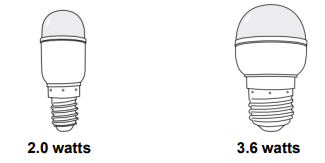
NOTE: Some LED replacement bulbs are not recommended for wet/damp environments. The refrigerator and freezer compartments are considered to be wet/damp environments. If using a brand of LED bulb other than the recommended Whirlpool LED bulb, read and follow all instructions on the replacement bulb’s packaging before installing it.
- Some models have interior incandescent 40 W bulbs that can be changed.
NOTE: Not all replacement bulbs will fit your refrigerator. Do not use an incandescent bulb in excess of 40 watts.
To Change a Light Bulb:
- Unplug refrigerator or disconnect power.
- Remove the light shield, as explained in the following sections. NOTE: To clean the light shield, wash it with warm water and liquid detergent. Before reinstalling, thoroughly rinse and dry the shield.
- Replace the burned-out light bulb, as explained in the following sections.
- Reinstall the light shield, as explained in the following sections.
- Plug in refrigerator or reconnect power.
Refrigerator Compartment – Upper Lights
Light Shield Removal: Slide the light shield toward the rear of the refrigerator and remove it from the light housing.

Replacement Bulb:
- If the burned-out light is a full-size LED bulb, replace it with a 2.0 W LED bulb.
- If the burned-out light is an incandescent bulb, replace it with an incandescent appliance bulb of the same size, shape, and wattage (40 W maximum).
Light Shield Reinstallation: Align the light shield in the grooves at the bottom edge of the light housing; then slide it forward until it snaps into place.
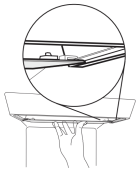
Refrigerator Compartment – Lower Lights
Light Shield Removal: Slide the light shield to the right to remove the left end from the wall slots; then pull the right end out of its wall slots.
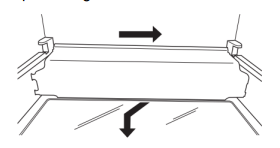
Replacement Bulb:
- If the burned-out light is a full-size LED bulb, replace it with a 3.6 W LED bulb.
- If the burned-out light is an incandescent bulb, replace it with an incandescent appliance bulb of the same size, shape, and wattage (40 W maximum).
Light Shield Reinstallation: Place the right end of the light shield into the wall slots; then snap the left end into its wall slots.
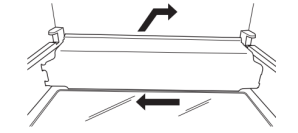
Freezer Compartment – Upper Light
Light Shield Removal: Gently squeeze the front and the bottom-rear edge of the light shield to release the tabs from the wall slots; then pull the light shield forward.
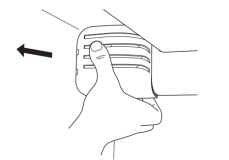
Replacement Bulb:
- If the burned-out light is a full-size LED bulb, replace it with a 3.6 W LED bulb.
- If the burned-out light is an incandescent bulb, replace it with an incandescent appliance bulb of the same size, shape, and wattage (40 W maximum).
Light Shield Reinstallation: Align the light shield in its proper position, and snap the tabs into the wall slots.
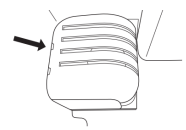
Freezer Compartment – Lower Light
Light Shield Removal: Slide the light shield to the left to remove the right end from the wall slots; then pull the left end out of its wall slots.
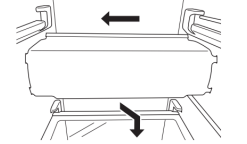
Replacement Bulb:
- If the burned-out light is a full-size LED bulb, replace it with a 3.6 W LED bulb.
- If the burned-out light is an incandescent bulb, replace it with an incandescent appliance bulb of the same size, shape, and wattage (40 W maximum).
Light Shield Reinstallation: Place the left end of the light shield into the wall slots; then snap the right end into its wall slots.
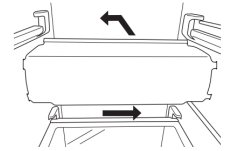
Freezer Shelf (number varies by model)
To Remove and Replace the Bottom Shelf:
- Lift up the front and back of the shelf, and remove from the cabinet. Be sure not to remove the retaining rods.
- Replace the shelf, aligning the rods with the cabinet ribs. Apply a little pressure on the shelf to attach the rods to the ribs of the cabinet.
To Remove and Replace the Mid and Top Shelf:
- With your hand, push the shelf from bottom to top until it is released from the holding rod. Pull the shelf until it is released from the rear rod. Remove from the cabinet.
- To replace the shelf:
- Replace rods into the support holes. Push the rods down so they click into the holes.
- Identify the front and rear trim of the shelf.

- Place the rear trim on the rear rod and push the shelf so it clicks the rod into the rear trim. (Keep the front raised while pushing.)
- Lower the front of the shelf until the front trim is on the rod and push the shelf down so it clicks the rod into the front trim.
NOTE: Be sure that both sides of the shelf are positioned evenly in the shelf support holes and the shelf is secure.
Vacation and Moving Care
Vacations
If You Choose to Leave Refrigerator On While You Are Away:
- Use up any perishables and freeze other items.
- If your refrigerator has an automatic ice maker and is connected to the household water supply, turn off the water supply to the refrigerator. Property damage can occur if the water supply is not turned off.
- If you have an automatic ice maker, turn off the ice maker. NOTE: Depending on your model, raise the wire shutoff arm to Off (up) position or press the switch to Off.
- Empty the ice bin.
If You Choose to Turn Refrigerator Off Before You Leave:
- Remove all food from the refrigerator.
- If your refrigerator has an automatic ice maker:
- Turn off the water supply to the ice maker at least one day ahead of time.
- When the last load of ice drops, raise the wire shutoff arm to the Off (up) position or move the switch to the Off setting.
- Depending on the model, turn the refrigerator control to Off or turn cooling off. See “Control Descriptions” in the Quick Start Guide.
- Unplug refrigerator or disconnect power.
- Clean, wipe, and dry thoroughly.
- Tape rubber or wood blocks to the tops of both doors to prop them open far enough for air to get in. This stops odor and mold from building up.
Moving
When you are moving your refrigerator to a new home, follow these steps to prepare it for the move.
- If your refrigerator has an automatic ice maker:
- Turn off the water supply to the ice maker at least one day ahead of time.
- Disconnect the water line from the back of the refrigerator.
- When the last load of ice drops, raise the wire shutoff arm to the Off (up) position or move the switch to the Off setting.
- Remove all food from the refrigerator and pack all frozen food in dry ice.
- Empty the ice bin.
- Depending on the model, turn the refrigerator control to Off or turn cooling off. See “Control Descriptions” in the Quick Start Guide.
- Unplug refrigerator or disconnect power.
- Clean, wipe, and dry thoroughly.
- Take out all removable parts, wrap them well, and tape them together so they don’t shift and rattle during the move.
- Depending on the model, raise the front of the refrigerator so it rolls more easily, or screw in the leveling legs so they don't scrape the floor. See “Adjust the Doors” or “Door Removal, Leveling and Alignment” in the online Feature Guide.
- Tape the doors closed and tape the power cord to the back of the refrigerator.
When you get to your new home, put everything back and refer to the Installation Instructions for preparation instructions. Also, if your refrigerator has an automatic ice maker, remember to reconnect the water supply to the refrigerator.
REFRIGERATOR FEATURES
Convertible Drawer Temperature Control (on some models)
The control can be adjusted to properly chill meats or vegetables. The air inside the pan is cooled to avoid “spot” freezing and can be set to keep meats at the National Livestock and Meat Board recommended storage temperatures of 28° to 32°F (–2° to 0°C).
To store meat: Set the control to one of the three Meat settings to store meat at its optimal storage temperature.
To store vegetables: Set the control to Veg to store vegetables at their optimal storage temperatures.
NOTE: If food starts to freeze, move the control to the right (less cold), toward the Veg setting. Remember to wait 24 hours between adjustments.
Crisper Humidity Control (on some models)
You can control the amount of humidity in the moisture-sealed crisper. Adjust the control to any setting between Low and High. LOW (open) for best storage of fruits and vegetables with skins. HIGH (closed) for best storage of fresh, leafy vegetables.
Dual Evaporator (on some models)
Some models come equipped with a dual sequential evaporation system which includes two separate evaporators for the refrigerator and freezer compartments.
Dual evaporation results in higher humidity, which helps keep foods in the refrigerator from spoiling as quickly and improves food quality and freshness in the freezer due to decreased freezer burn. In addition, the dual evaporation system helps keep food smells in the refrigerator from transferring to ice in the freezer. NOTE: The dual evaporation system is always activated when your refrigerator is operating. You do not need to press any buttons to turn it on.
Water and Ice Dispensers
On how to use your water and ice dispensers, see the online “Side-by-Side Refrigerator Dispensers” Feature Guide.
NOTES:
- Connect to potable water supply only.
- The dispensing system will not operate when either door (refrigerator or freezer) is open.
- Allow 24 hours for the refrigerator to cool down and chill water.
- Allow 24 hours to produce the first batch of ice. Discard the first three batches of ice produced. Wait 72 hours for full ice production.
- On some models, the display screen on the dispenser control panel will turn off automatically and enter “sleep” mode when the control buttons and dispenser pads have not been used for 2 minutes or more. While in “sleep” mode, the first press of a control button will only reactivate the display screen, without changing any settings.
Flush the Water System
Air in the water dispensing system can cause the water dispenser to drip. After connecting the refrigerator to a water source or replacing the water filter, flush the water system. Flushing the water dispensing system forces air from the water line and filter and prepares the water filter for use. NOTE: As air is cleared from the system, water may spurt out of the dispenser.
- Using a sturdy container, depress and hold the water dispenser pad for 5 seconds; then release it for 5 seconds.
- Repeat step 1 until water begins to flow.
- Once water begins to flow, continue depressing and releasing the dispenser pad (5 seconds on, 5 seconds off) until a total of 3 gal. (12 L) has been dispensed.
Additional flushing may be required in some households
The Water Dispenser
IMPORTANT: Dispense at least 1 qt. (1 L) of water every week to maintain a fresh supply. If the flow of water from the dispenser decreases, it could be caused by low water pressure.
- With the water filter removed, dispense 1 cup (237 mL) of water. If 1 cup of water is dispensed in 8 seconds or less, the water pressure to the refrigerator meets the minimum requirement.
- If it takes longer than 8 seconds to dispense 1 cup of water, the water pressure to the refrigerator is lower than recommended. See “Water Supply Requirements” or online “Troubleshooting” for suggestions.
Ice Maker and Storage Bin
- Allow 24 hours to produce the first batch of ice. Discard the first three batches of ice produced.
- The quality of your ice will be only as good as the quality of the water supplied to your ice maker. Avoid connecting the ice maker to a softened water supply. Water softener chemicals (such as salt) can damage parts of the ice maker and lead to poor quality ice. If a softened water supply cannot be avoided, make sure the water softener is operating properly and is well maintained.
- Do not use anything sharp to break up the ice in the storage bin. This can cause damage to the ice container and the dispenser mechanism.
- Do not store anything on top of or in the ice maker or storage bin.
Style 1
Turning the Ice Maker On/Off:
The On/Off switch, located on the left wall of the freezer door, can only be accessed when the ice storage bin has been removed. See the following section for bin removal instructions.
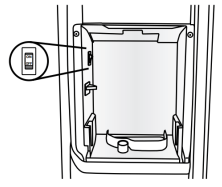
- To turn on the ice maker, flip the switch to the On (up) position.
- To manually turn off the ice maker, flip the switch to the Off (down) position.
NOTE: The ice maker has an automatic shutoff to keep the storage bin from overfilling during normal operation. As ice is made, the ice cubes will fill the ice storage bin, and the ice cubes will raise the shutoff arm to the Off (arm up) position. When the storage bin is at full capacity, the ice maker will automatically stop ice production, but the ice maker On/Off switch will remain in the On (up) position.
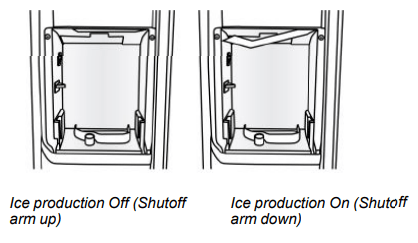
Removing and Replacing the Ice Storage Bin:
1. Press down the release lever and tilt the bucket outward. Use both hands to hold the base of the storage bin, and then lift it up and out.
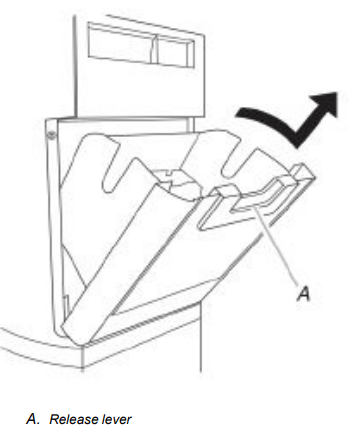
NOTE: It is not necessary to flip the ice maker On/Off switch to the Off (down) position when removing the storage bin. The storage bin sensor, located on the left wall (right wall on some models) of the freezer door, stops the ice maker from producing ice if the door is open or the storage bin is removed.
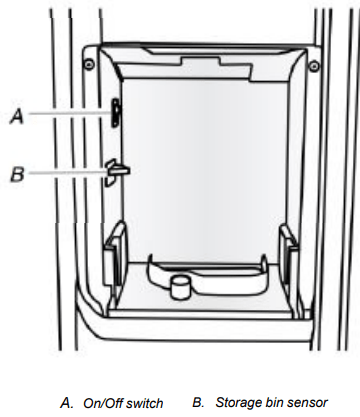
2. Replace the bin by sliding it onto the door, and then tilting it back into an upright position. The release lever will click when the bin is securely in place.
Style 2
Turning the Ice Maker On/Off:
- To turn on the ice maker, lower the wire shutoff arm to the On position.
- To manually turn off the ice maker, lift the wire shutoff arm to the Off (arm up) position and listen for the click. Ice can still be dispensed, but no more can be made.
NOTE: The ice maker has an automatic shutoff to keep the storage bin from overfilling during normal operation. As ice is made, the ice cubes will fill the ice storage bin, and the ice cubes will raise the wire shutoff arm to the Off (arm up) position. Do not force the wire shutoff arm up or down.
Removing and Replacing the Ice Storage Bin:
1. Pull the covering panel up from the bottom.
2. Lift the wire shutoff arm so it clicks into the Off (up) position.
3. Lift up the front of the storage bin and pull it out.
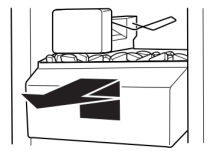
4. Replace the bin by pushing it in all the way or the dispenser will not work.
5. To restart ice production, lower the wire shutoff arm to the On (down) position. Make sure the door is closed tightly
Style 3
Turning the Ice Maker On/Off:
- To turn on the ice maker, lift open the ice maker door and lower the wire shutoff arm to the On position.
- To manually turn off the ice maker, lift the wire shutoff arm to the Off (arm up) position and listen for the click. Ice can still be dispensed, but no more can be made.
NOTE: The ice maker has an automatic shutoff to keep the storage bin from overfilling during normal operation. As ice is made, the ice cubes will fill the ice storage bin, and the ice cubes will raise the wire shutoff arm to the Off (arm up) position. Do not force the wire shutoff arm up or down.
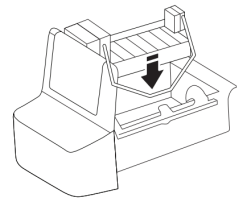
Removing and Replacing the Ice Storage Bin:
- Lift and hold open the ice maker door.
- Lift the wire shutoff arm so it clicks into the Off (up) position. Release the ice maker door.
- Lift up the front of the storage bin and pull it out.
- Replace the bin by pushing it in all the way or the dispenser will not work.
- To restart ice production, lift open the ice maker door and push the wire shutoff arm down to the On position.
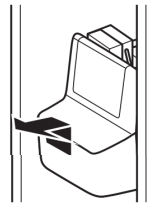
Style 4
Turning the Ice Maker On/Off:
The On/Off switch is located on the bottom of the ice maker, which can be accessed by lifting and opening the ice maker door.
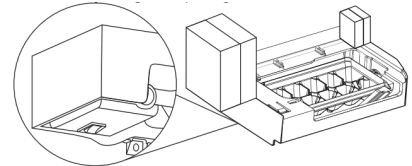
- To turn on the ice maker, lift open the ice maker door, and flip the switch to the On (right) position.
- To manually turn off the ice maker, lift open the ice maker door, and flip the switch to the Off (left) position. Ice can still be dispensed, but no more can be made.
NOTE: Your ice maker has an automatic shutoff to keep the storage bin from overfilling during normal operation. As ice is made, the ice cubes will fill the ice storage bin, and the ice cubes will raise the shutoff arm to the Off (arm up) position. When the storage bin is at full capacity, the ice maker will automatically stop ice production, but the ice maker On/Off switch will remain in the On (up) position.
Removing and Replacing the Ice Storage Bin:
- Pull the covering panel up from the bottom.
- Lift the plastic shutoff arm so it clicks into the Off (up) position.
- Lift up the front of the storage bin and pull it out
- Replace the bin by pushing it in all the way or the dispenser will not work.
- To restart ice production, lower the plastic shutoff arm to the On (down) position. Make sure the door is closed tightly
Style 5
Turning the Ice Maker On/Off:
The ON/OFF switch is located on the right side of the ice maker, which can be accessed by lifting and opening the ice maker door.
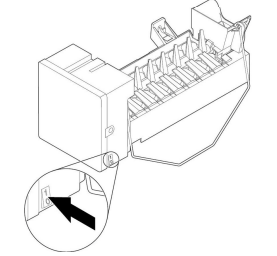
- To turn on the ice maker, lift open the ice maker door, and flip the switch ON/OFF to the ON (I) position.
- To manually turn the ice maker off, lift open the ice maker door, and flip the switch ON/OFF to the OFF (O) position.
NOTE: The ice maker has an automatic shutoff to keep the storage bin from overfilling during normal operation. As ice is made, the ice cubes will fill the ice storage bin and the ice cubes will raise the wire shutoff arm up. When the storage bin is at full capacity, the ice maker will automatically stop ice production, but the ice maker ON/OFF rocker switch will remain in the ON (I) position. Do not force the wire shutoff arm up or down.
Removing and Replacing the Ice Storage Bin:
- Pull the covering panel up from the bottom.
- Move the ON/OFF rocker switch to the OFF (O) position.
- Lift up the front of the storage bin and pull it out.
- Replace the bin by pushing it in all the way or the dispenser will not work.
- To restart ice production, move the ON/OFF rocker switch to the ON (I) position Make sure the door is closed tightly.
TROUBLESHOOTING
Operational notes
- The Ice Maker water valve contains a flow washer that acts like a pressure regulator to control the water flow. For the Ice Maker to work properly, the water pressure in your home must be between 20 and 120 pounds per-square-inch (psi). If you encounter problems with your Ice Maker’s ability to produce ice, call your water utility company and have the water pressure checked.
- The Ice Maker’s water valve is equipped with two strainers: a plastic basket type and a wire-mesh screen. Both of these can be cleaned by turning off the water and disassembling the water valve (your service center should be able to provide this service). If local water conditions require periodic cleaning, or if you use a well as a water source, you should consider installing a second water strainer in the water line. You can obtain a water strainer from your local appliance dealer.
Troubleshooting chart
The following chart lists several common problems that could occur with your Ice Maker
| PROBLEM | CAUSE |
One or more of the following sounds is heard:
| The water valve is operating. Water is entering the Ice Maker fill cup. Ice is being dumped into the ice bin. |
| Ice tastes stale. | The ice is old. Make a new batch. |
| Water in Ice Maker overflows. | Refrigerator or Ice Maker is not level. If the Ice Maker still overflows after leveling, turn off the Ice Maker’s water supply at the shut-off valve, and raise the Ice Maker’s bail arm to the “off” position; then contact your local service center. |
| Not enough ice. | It will take 72 hours to fill the ice bucket. The ice maker will make ice every 2 to 3 hours. For more ice, adjust the freezer control for a colder setting |
| Ice making has stopped. | Be sure that the bail arm is lowered into the ice bucket. Make sure that the water shut-off valve is on. The water shut-off valve or the water valve screen is clogged (contact your local service center). |
See other models: WUR50X24HZ WFE540H0ES WFE530C0ES WFE320M0ES W10620402A
